Japan
Wood Products Prices
Dollar Exchange Rates of 18th
July 2016
Japan Yen 106.15
Reports From Japan
Pre-Brexit consumer confidence likely to be
undone
June consumer confidence in Japan improved for a second
month on the back of stable employment conditions
according to the Cabinet Office Consumer Confidence
Index report.
This latest survey was completed before the volatile
currency and stock market conditions experienced as a
result of the British referendum to leave the EU.
In the June survey all four of the sentiment indices
improved with consumers expressing optimism on
employment, willingness to buy new durable goods,
overall livelihood prospects and their assessment of
income growth prospects.
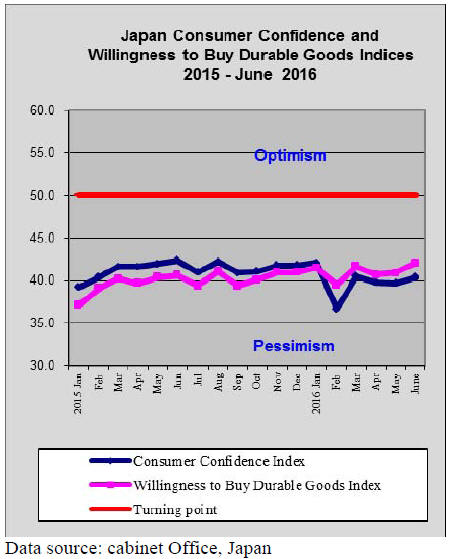
Second monthly decline in machinery orders
The total value of machinery orders received by 280
manufacturers surveyed for the Cabinet Office in Japan
fell 11.5% in May from the previous month.
Private sector machinery orders, excluding those for ships
and from power companies, declined a seasonally adjusted
1.4% in May. The decline in May was the second
consecutive drop, a sign that enterprises are holding back
on spending.
See:
http://www.esri.cao.go.jp/en/stat/juchu/juchu-e.html
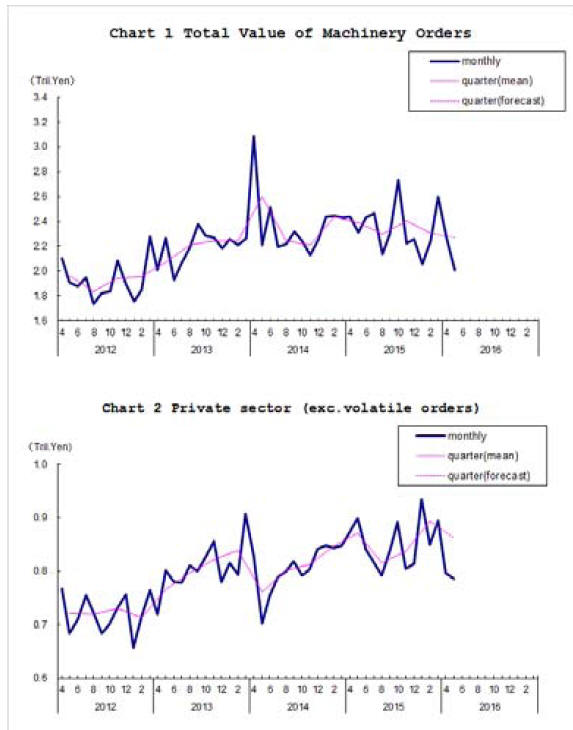
Business confidence double whammy
Japan’s Ministry of Finance has released its assessment of
business sentiment determined from a survey of some
13,000 small, medium and large sized companies.
The survey shows that confidence among large companies
weakened in the six months to June this year explained by
forced suspension of production in many factories due to
the severe earthquake in western Japan and because the
yen has strengthened undermining competiveness.
The June level confidence index was down nearly 8 point
far worse than the forecast 2 point drop anticipated and is
worse than the low experienced in 2014.
The business sentiment index for the July to September
period is expected to rebound according to government
forecasts.
Yen weakens – a welcome sign for Japanese exporters
The US dollar rose mid-month following the release of US
housing starts data which, on the heels of firm
employment figures, was a further indication that the US
economy is strengthening. The June US employment
figures showed companies added almost 300,000 new jobs
well above expectations.
Against this backdrop the dollar firmed against the yen
pushing the Japanese currency down to 106 to the US
dollar, the lowest since June 24, Brexit day.

Over supply of housing rental units
Record-low interest rates and revisions to Japan’s
inheritance tax law have resulted in a significant shift in
investments into construction of rental housing. For Japan
as a whole the number of units built in April this year was
around 15% higher than in April last year. The result of
this is that occupancy rates have been falling.
The Ministry of Land, Infrastructure, Transport is
expecting some 450,000 rental units will be built this year.
Analysts expect this situation to continue as the population
declines.
The other problem facing Japanese is that real wages for
the social group that usually rent a home has fallen almost
10% since 1999 which has pushed average expenditure on
rents to about 30% of income for this group, a likely
explanation why more young people are tending to live at
home for much longer than previously.
May Housing starts beat expectations – 5th monthly
increases to-date
Data from Japan’s the Ministry of Land, Infrastructure and
Transport shows starts rose by 9% compared to May last
year. The May data signals the fifth consecutive monthly
increase in housing starts.
The data from the Ministry also shows orders for housing
placed with the top construction companies expanded
more than 30% compared to the decline reported in April.
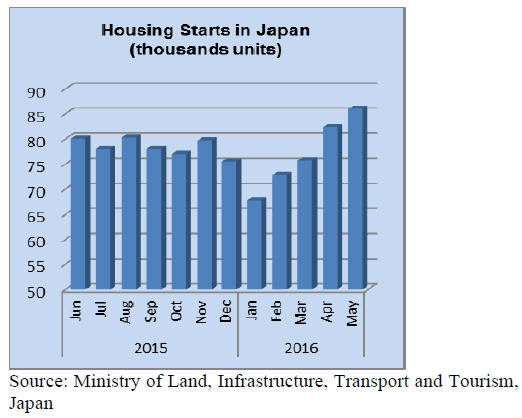
Japan’s furniture imports
While Japan’s office furniture imports have remained
remarkably stable over the past 12 months more volatilty
has been observed in the value of both kitchen and
bedroom furniture demand for which is affected by
consumer spending and willingness to purchase durable
goods, items on which spending can easily be deferred.
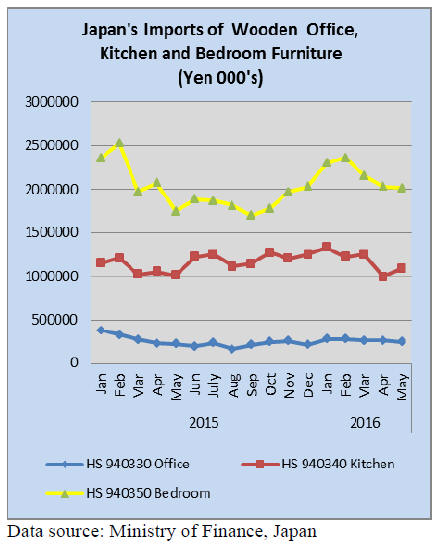
In April this year kitchen furniture imports fell
well below
the average monthly flow. For bedroom furniture a
declining trend in imports first became noticeable in
March and continued into April after which import values
steadied.
Office furniture imports (HS 940330)
Year on year, imports of office furniture in May 2016
were up 8% but compared to the previous month May
imports were down 6%.
From the highs in January this year Japan’s imports of
wooden office furniture have consistently fallen. Business
confidence and a lack of investment in production capacity
across enterprises of all sizes has dampened demand for
office furniture.

China and Portugal continue as top ranked suppliers
of
wooden office furniture but in May this year shippers in
Taiwan P.o.C leapt into the top three. It should be noted
that China alone ships more wooden office furniture to
Japan than the combined shipments from all other
suppliers.
Suppliers in Asia account for most wooden furniture
shipments to Japan with only Germany and Italy shipping
a significant value of wooden office furniture.
Kitchen furniture imports (HS 940340)
In contrast to the sharp fall in Japan’s imports of kitchen
furniture in April, May saw an equally sharp increase
bringing shipments up to around the average for the year
to date.
Year on year May imports of wooden kitchen furniture
rose 7.5% and month on month May 2016 imports were up
9.5% on levels in April.
Vietnam shippers dominate Japan’s imports of wooden
kitchen furniture followed by the Philippines. The surprise
in May was that Indonesia replaced China as the third
largest supplier.

May imports of wooden kitchen furniture from Vietnam
were up 7% month on month with the Philippines posting
a 26% rise in shipments and Indonesia seeing shipments
rise 7%.
Germany features as the top non-Asian supplier of
wooden
kitchen furniture and in May was joined for the first time
by Slovenia.
Bedroom furniture imports (HS 940350)
There was almost no change in the value of Japan’s
wooden bedroom furniture imports over the past two
months but year on year imports in May 2016 were up
15%. Two countries, China and Vietnam, account for over
87% of all wooden bedroom furniture imports into Japan.
The only other significant shipper is Malaysia but, at just
3% of all wooden bedroom furniture imports, the
challenge is to capture market share from the top two
suppliers.

Trade news from the Japan Lumber Reports (JLR)
For the JLR report please see:
http://www.nmokuzai.
com/modules/general/index.php?id=7
Wood demand projection by the Forest Agency
The Forestry Agency held the meeting to figure out
demand for wood products for 2016. It shows increase
over last year on all the products for both domestic and
imported items. It does not reflect any influence of
postponement of consumption tax increase and destroy of
Akita plywood mill by fire. Also it was made before
sudden appreciation of the yen after UK exited from EU.
On plywood, domestic production increases to 3,009 M
cbms, 8.6% more than 2014 while imported plywood
decreases to 2,825 M cbms, 2.1% less so domestic share
will surpass imports after 20 years. The demand would
increase for active housing starts by record low mortgage
interest rate and restoration demand on Kumamoto
earthquake.
Also domestic plywood products are newly developed for
floor base and concrete forming panel which have
previously been supplied from South Sea imported
plywood so this is new demand for domestic plywood.
Supply of laminated lumber for the third quarter will
decline compared to the same quarter last year.Domestic
supply will be limited by shortage of lamina supply
despite active demand while European supply will decline
because of summer vacation season during the third
quarter.
Imported lumber for the second half of the year would be
the same as last year in which European supply would
decrease because of higher lamina prices. Russian lumber
supply for the fourth quarter would decline due to log
supply shortage and over supply of low grade lumber.
Radiata pine logs and lumber from New Zealand and Chile
would increase with hope of recovery of crating lumber
demand.
For imported logs for the second half of the year, the
supply would vary by the sources. North American logs
would increase by summer harvest season. South Sea log
supply would continue declining by confusion of harvest
tax in Sabah, Malaysia. Russian logs would also decline
by difficulty of log harvest.
Domestic log export, which has been increasing year after
year by 20-30%, is leveling now. Log export during
January and April this year was slightly declined in value.
By items, logs decreased by 14.3% and lumber by
7.5%.
By destination, China increased by 12.6% but Korea
decreased by 30.8% and Taiwan decreased by 28.1%.
Recent trend of strong yen is discouraging factor for the
export.
South Sea (tropical) logs
Log export prices in June are firming. In Sarawak, log
suppliers have hard time to deal with the new regulation
and log production has been stalled. Moreover, Sarawak
experiences occasional heavy rain, which hampers log
harvest and hauling in muddy ground.
The Japanese log importers barely manage to fill up ships
with Sabah logs. In Sabah, weather improves and log
production is getting steady but log supply for local
plywood mills is busy so that there is not enough surplus
logs for export.
With busy demand by local mills, Indian buyers continue
aggressive purchase, which makes log suppliers bullish.
Particularly Sarawak meranti is low in inventory so the
prices seem to go up. Sarawak meranti regular log prices
for Japan are US$270-275 per cbm FOB. Small meranti
are US$250 and super small are US$235.
Plywood
Domestic softwood plywood business is booming. The
manufacturers recorded the highest production for eight
months since last October with monthly production of
233,500 cbms. There has not been any such record of
high production for prolonging period.
The shipment has also been very active with 238,500
cbms a month for last twelve months. The shipment of last
April when Akita Plywood had fire damage was record
high of 247,000 cbms.
Precutting plant operations increased in June. The largest
precutting plant recorded the highest processing volume
and others say that orders are 130% of their capacity.
Thick panel supply of domestic softwood plywood
continues to be tight. Since operating days are more in
June, supply increase was expected but the manufacturers
gave priority to catch up order balance carried over from
May so overall supply in June did not increase. Since there
are so many short items, some manufacturers suffer
inefficient operations to switch one to the other, which
takes more man power.
Large precutting plants enjoy more orders and busy
operations but even large precutting plants experience
delay of plywood delivery.
In wholesale channel, there is not much confusion but
some struggle to secure special items like thick panel with
tongue and groove.
Imported plywood demand should have been high in June
and July but orders are not as much as usual years then the
buyers restrain from buying because of sudden
appreciation of the yen in late June. Importers anticipate
further decline of yen prices so when one tries to sell,
lower prices are offered since future cost would be lower
and there are some spot deals as low as future prices
although wholesalers carry higher cost items before the
yen got strong.
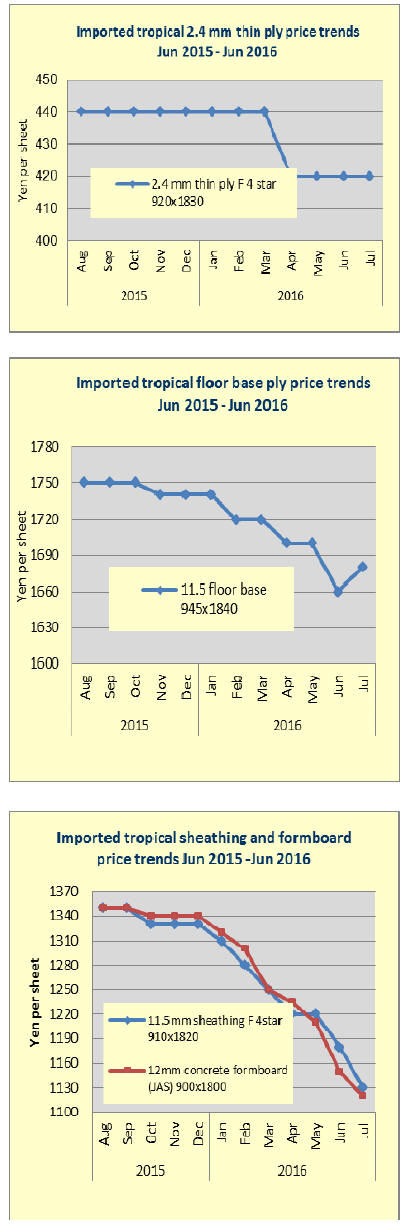
New chairman of the JLIA
The Japan Lumber Importers Association held its general
meeting on 7 June and elected Mr. A. Fukuda (Sumitomo
Forestry) as Chairman.
The main subjects are the Association tries to establish
stable supply and demand of wood and to expand use of
wood as domestic wood and imported wood fit into proper
purposes then will have closer communications with
overseas wood related groups and share the information
widely.
The Association confirmed to try importing legally proven
wood much more than before after the Diet adopted the
bill to promote using legally approved wood in May.
Also to encourage this move, the Association
acknowledged that the special membership fee is reduced
by 50 sen per cubic meter for the import of legal wood.
Actual result of import of legally proven wood in 2015 by
the members was 72.3% in total volume, 2.4 points more
than 2014 but only 35.6% of proven wood was sold as
legal wood.
Akita Plywood rebuilds the second plant
Akita plywood Mukaihama second plant burnt down by
fire in early April which had monthly production of
10,000 cbms of thick panel. Rebuilding plan has already
started. Fortunately steel frame of the plant remains
undamaged.
The plan is to finish designs in June and ordered
machinery then will restart operation in December this
year. The new plant will have less workers but more
production. It will produce at least 12-13,000 cbms of not
only thick panel but also floor base and other nonstructural
panels.
Fire protection measures are priority matter for new plant.
Total monthly production of Akita Plywood was about
40,000 cbms then by loss of the second plant, the
production dropped by about 25%.
Radiata pine sawmills gave up price increase
The New Zealand Log Sawmillers’ Conference of Japan
held the meeting on June 3 to discuss how to deal with
increasing log prices.
New Zealand radiata pine log export prices are pushed up
by higher China prices but demand for crating lumber and
pallet in Japan continues depressed and prolonging slump
puts sawmills in unprofitable operations.
At the meeting, majority of radiate pine sawmills feels it is
impossible to ask higher lumber prices in demand absent
market so they decided to give up price increase.
International environmental groups demand only
verified legal wood to be utilised
Eighteen international environmental protecting groups
submit the note to the Prime Minister Abe, requesting the
Japanese government should take determined control on
use of legally proved wood and secure participation of
corporations in wide range since the law to promote using
legal wood may not be enough to stop dealing of illegally
harvested wood, which the prime minister promised at the
recent G7 meeting.
The note requests that every company, which import wood
from suppliers, which have doubt of dealing of illegal
harvested wood must be registered by the new law, that
due diligence standard to deal with risk of illegal harvest
in supply chain must be stipulated and if risk is great and
there is not sufficient proof, wood importer must obtain
reliable independent information to prove legality.
If registered member fails to observe the law, registration
must be canceled and the name must be disclosed publicly,
that information regarding procurement actions from every
registered member must be collected to find out effect of
the law.
The note submit by following 18 groups. Global Witness,
Environmental Investigation Agency, Market for change,
Center for International Environmental Law, National
Wildlife Federation, Green Peace Japan, Green Peace
International, Rainforest Action Network, Bruno Manser
Funds, Japan Tropical Forest Action Network, Sarawak
Campaign Committee, Global Environmental Forum,
International Environment NGO, Friends of the Earth
Japan, International NGO Human Rights Now, FERN,
Sierra Club, Rainforest Foundation Norway and CPI.
|